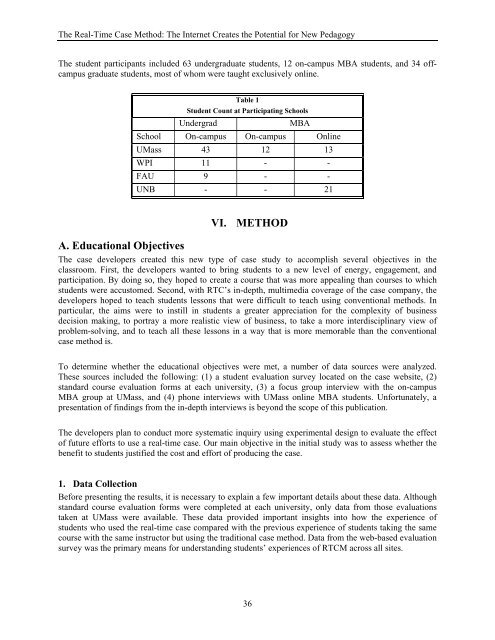Elements of Quality Online Education cation
Elements of Quality Online Education cation
Elements of Quality Online Education cation
You also want an ePaper? Increase the reach of your titles
YUMPU automatically turns print PDFs into web optimized ePapers that Google loves.
The Real-Time Case Method: The Internet Creates the Potential for New PedagogyThe student participants included 63 undergraduate students, 12 on-campus MBA students, and 34 <strong>of</strong>fcampusgraduate students, most <strong>of</strong> whom were taught exclusively online.Table 1Student Count at Participating SchoolsUndergradMBASchool On-campus On-campus <strong>Online</strong>UMass 43 12 13WPI 11 - -FAU 9 - -UNB - - 21VI. METHODA. <strong>Edu<strong>cation</strong></strong>al ObjectivesThe case developers created this new type <strong>of</strong> case study to accomplish several objectives in theclassroom. First, the developers wanted to bring students to a new level <strong>of</strong> energy, engagement, andparticipation. By doing so, they hoped to create a course that was more appealing than courses to whichstudents were accustomed. Second, with RTC’s in-depth, multimedia coverage <strong>of</strong> the case company, thedevelopers hoped to teach students lessons that were difficult to teach using conventional methods. Inparticular, the aims were to instill in students a greater appreciation for the complexity <strong>of</strong> businessdecision making, to portray a more realistic view <strong>of</strong> business, to take a more interdisciplinary view <strong>of</strong>problem-solving, and to teach all these lessons in a way that is more memorable than the conventionalcase method is.To determine whether the edu<strong>cation</strong>al objectives were met, a number <strong>of</strong> data sources were analyzed.These sources included the following: (1) a student evaluation survey located on the case website, (2)standard course evaluation forms at each university, (3) a focus group interview with the on-campusMBA group at UMass, and (4) phone interviews with UMass online MBA students. Unfortunately, apresentation <strong>of</strong> findings from the in-depth interviews is beyond the scope <strong>of</strong> this publi<strong>cation</strong>.The developers plan to conduct more systematic inquiry using experimental design to evaluate the effect<strong>of</strong> future efforts to use a real-time case. Our main objective in the initial study was to assess whether thebenefit to students justified the cost and effort <strong>of</strong> producing the case.1. Data CollectionBefore presenting the results, it is necessary to explain a few important details about these data. Althoughstandard course evaluation forms were completed at each university, only data from those evaluationstaken at UMass were available. These data provided important insights into how the experience <strong>of</strong>students who used the real-time case compared with the previous experience <strong>of</strong> students taking the samecourse with the same instructor but using the traditional case method. Data from the web-based evaluationsurvey was the primary means for understanding students’ experiences <strong>of</strong> RTCM across all sites.36
















